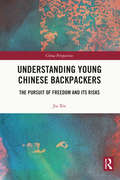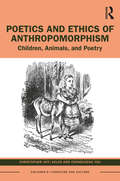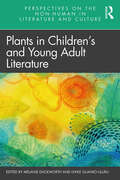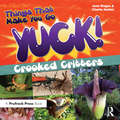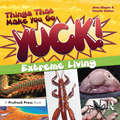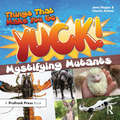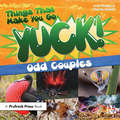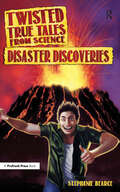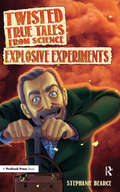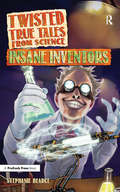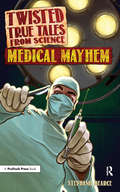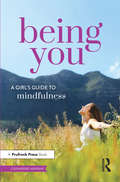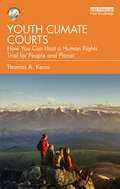- Table View
- List View
Understanding Young Chinese Backpackers: The Pursuit of Freedom and Its Risks (China Perspectives)
by Jia XieAn activity that originated in Western societies, backpacking has gained increasing popularity among Chinese millennials. In a spirit of the ‘search for self’, young Chinese backpackers have sought to display their pursuit of freedom, independence and responsibility within an increasingly individualised society through backpacking. This volume investigates contemporary young Chinese persons’ views on backpacking culture and backpackers. A group of Chinese backpackers are studied using interview and participant observation, and focus groups are conducted to study young professionals’ and university students’ attitudes towards backpacking. The results indicate a profound cultural change along with a degree of division. On the one hand, the backpackers often begin their journey due to a desire to pursue freedom, and use the pursuit as a process of reflexive awareness; on the other hand, the risks of pursuing a freewheeling lifestyle within an individualised society drive the majority of them to return home. The author concludes that this phenomenon is a kind of ‘staged individualism’, describing how Chinese millennials strike a balance between individual interests and wider social obligations. Students and scholars of sociology tourism, and youth culture will be interested in this volume.
Poetics and Ethics of Anthropomorphism: Children, Animals, and Poetry (Children's Literature and Culture)
by Christopher Kelen Jo You ChengchengPoetics and Ethics of Anthropomorphism: Children, Animals, and Poetry investigates a kind of poetry written mainly by adults for children. Many genres, including the picture book, are considered in asking for what purposes ‘animal poetry’ is composed and what function it serves. Critically contextualising anthropomorphism in traditional and contemporary poetic and theoretical discourses, these pages explore the representation of animals through anthropomorphism, anthropocentrism, and through affective responses to other-than-human others. Zoomorphism – the routine flipside of anthropomorphism – is crucially involved in the critical unmasking of the taken-for-granted textual strategies dealt with here. With a focus on the ethics entailed in poetic relations between children and animals, and between humans and nonhumans, this book asks important questions about the Anthropocene future and the role in it of literature intended for children. Poetics and Ethics of Anthropomorphism: Children, Animals, and Poetry is a vital resource for students and for scholars in children’s literature.
Poetics and Ethics of Anthropomorphism: Children, Animals, and Poetry (Children's Literature and Culture)
by Christopher Kelen Jo You ChengchengPoetics and Ethics of Anthropomorphism: Children, Animals, and Poetry investigates a kind of poetry written mainly by adults for children. Many genres, including the picture book, are considered in asking for what purposes ‘animal poetry’ is composed and what function it serves. Critically contextualising anthropomorphism in traditional and contemporary poetic and theoretical discourses, these pages explore the representation of animals through anthropomorphism, anthropocentrism, and through affective responses to other-than-human others. Zoomorphism – the routine flipside of anthropomorphism – is crucially involved in the critical unmasking of the taken-for-granted textual strategies dealt with here. With a focus on the ethics entailed in poetic relations between children and animals, and between humans and nonhumans, this book asks important questions about the Anthropocene future and the role in it of literature intended for children. Poetics and Ethics of Anthropomorphism: Children, Animals, and Poetry is a vital resource for students and for scholars in children’s literature.
Plants in Children’s and Young Adult Literature (Perspectives on the Non-Human in Literature and Culture)
by Melanie Duckworth Lykke Guanio-UluruFrom the forests of the tales of the Brothers Grimm to Enid Blyton’s The Faraway Tree, from the flowers of Cicely May Barker’s fairies to the treehouse in Andy Griffith and Terry Denton’s popular 13-Storey Treehouse series, trees and other plants have been enduring features of stories for children and young adults. Plants act as gateways to other worlds, as liminal spaces, as markers of permanence and change, and as metonyms of childhood and adolescence. This anthology is the first compilation devoted entirely to analysis of the representation of plants in children’s and young adult literatures, reflecting the recent surge of interest in cultural plant studies within the environmental humanities. Mapping out and presenting an internationally inclusive view of plant representation in texts for children and young adults, the volume includes contributions examining European, American, Australian, and Asian literatures and contributes to the research fields of ecocriticism, critical plant studies, and the study of children’s and young adult literatures.
Plants in Children’s and Young Adult Literature (Perspectives on the Non-Human in Literature and Culture)
by Melanie DuckworthFrom the forests of the tales of the Brothers Grimm to Enid Blyton’s The Faraway Tree, from the flowers of Cicely May Barker’s fairies to the treehouse in Andy Griffith and Terry Denton’s popular 13-Storey Treehouse series, trees and other plants have been enduring features of stories for children and young adults. Plants act as gateways to other worlds, as liminal spaces, as markers of permanence and change, and as metonyms of childhood and adolescence. This anthology is the first compilation devoted entirely to analysis of the representation of plants in children’s and young adult literatures, reflecting the recent surge of interest in cultural plant studies within the environmental humanities. Mapping out and presenting an internationally inclusive view of plant representation in texts for children and young adults, the volume includes contributions examining European, American, Australian, and Asian literatures and contributes to the research fields of ecocriticism, critical plant studies, and the study of children’s and young adult literatures.
Things That Make You Go Yuck!: Crooked Critters
by Jennifer Dlugos Charlie HattonNature doesn't always play nice, and Things That Make You Go Yuck!: Crooked Critters showcases some of the worst offenders in the plant and animal kingdoms. You'll meet trespassing toads, insects in disguise, brood-borrowing cuckoos, and many more. It's a rogue's gallery of some of nature's roughest, meanest species. Whether it's nature's slimiest organisms or the weirdest mutations, Things That Make You Go Yuck! celebrates survival of the fittest, grossest, craziest, and creepiest things in nature, proving once and for all that life in the wild is anything but ordinary.Ages 9-12
Things That Make You Go Yuck!: Extreme Living
by Jennifer Dlugos Charlie HattonLife isn't always easy, but some organisms take hard living to the extreme. Things That Make You Go Yuck!: Extreme Living looks at organisms living in the weirdest of ways: swimming miles deep in the ocean, freezing on icy mountaintops, boiling in hot springs, or even floating in space. You'll also find critters bigger, smaller, softer, longer, and stretchier than you ever thought possible. Whether it's nature's slimiest organisms or the weirdest mutations, Things That Make You Go Yuck! celebrates survival of the fittest, grossest, craziest, and creepiest things in nature, proving once and for all that life in the wild is anything but ordinary.Ages 9-12
Things That Make You Go Yuck!: Mystifying Mutants
by Jennifer Dlugos Charlie HattonHexapus. Singing mice. Spider worm. They sound like creatures from horror movies, but they are all real-life mutants that creep, crawl, and slither among us. In Things That Make You Go Yuck!: Mystifying Mutants, you'll learn that genes can be a freaky and fascinating business. From two-toned lobsters to hairless cats, this book showcases the strangest and most shocking genetic mutants in the plant and animal kingdoms. Whether it's nature's slimiest organisms or the weirdest mutations, Things That Make You Go Yuck! celebrates survival of the fittest, grossest, craziest, and creepiest things in nature, proving once and for all that life in the wild is anything but ordinary.Ages 9-12
Things That Make You Go Yuck!: Odd Couples
by Jennifer Dlugos Charlie HattonIt takes two to tango—but in the wild, two can do much crazier things than dance. In Things That Make You Go Yuck!: Odd Couples, you'll find out about nature's strangest dating rituals, cooperative couples, and parasitic pests. You'll explore symbiotic pairings like crabs that carry sea urchins on their backs, and hybrid “franken-species” that seem like something out of a science-fiction tale. Whether it's nature's slimiest organisms or the weirdest mutations, Things That Make You Go Yuck! celebrates survival of the fittest, grossest, craziest, and creepiest things in nature, proving once and for all that life in the wild is anything but ordinary.Ages 9-12
Twisted True Tales From Science: Disaster Discoveries
by Stephanie BearceLondon was once covered in a fog so polluted that it killed 12,000 people. The Aleppo earthquake killed 230,000 people, and a wall of water mysteriously wiped out the whole town of Burnham-on-Sea. All of these were catastrophic disasters, but they led to important discoveries in science. Learn about how the earth turned to liquid in New Zealand and what happens when a tsunami meets a nuclear reactor. These stories may sound twisted and strange, but they are all true tales from science!Ages 9-12
Twisted True Tales From Science: Explosive Experiments
by Stephanie BearceTwo thousand years ago, Chinese scientists were looking for a medicine that would make them live forever. Instead, they blew up their lab and discovered gunpowder. Alfred Nobel blew up his laboratory twice before he discovered the formula for dynamite. Learn about the Apollo 13 and Challenger explosions and the strange space explosions caused by top secret Starfish Prime. These stories may sound twisted, but they're all true tales from science!Ages 9-12
Twisted True Tales From Science: Insane Inventors
by Stephanie BearceNikola Tesla was crazy smart. He invented the idea for cell phones in 1893, discovered alternating current, and invented a death ray gun. Of course, he also talked to pigeons, ate only boiled food, and was scared of women who wore jewelry. He was an insane inventor. So was Henry Cavendish, who discovered hydrogen, calculated the density of the Earth, and was so scared of people that he had to write notes to communicate. Sir Isaac Newton discovered the laws of gravity, believed in magic, and thought he could make a potion to create gold. These stories may sound twisted, but they're all true tales from science!Ages 9-12
Twisted True Tales From Science: Medical Mayhem
by Stephanie BearceGround-up mummy bones, leeches sucking human blood, and a breakfast of dried mouse paste. It sounds like a horror movie, but those were actual medicines prescribed by early doctors. Medical students studied anatomy on bodies stolen from graves and had to operate on people while they were awake. Learn about the medicines that came from poison and doctors who experimented on themselves and their families. It's a twisted tale of medical mayhem, but it's all true!Ages 9-12
Being You: A Girl's Guide to Mindfulness
by Catharine HannayDo you ever feel stressed, anxious, or overwhelmed? As a teen girl, you're under a lot of pressure. Mindfulness can help. Being You explores mindfulness as a simple but powerful way to center oneself and tap into one's own inner wisdom and strength. This book:
Things That Make You Go Yuck!: Crooked Critters
by Jennifer Dlugos Charlie HattonNature doesn't always play nice, and Things That Make You Go Yuck!: Crooked Critters showcases some of the worst offenders in the plant and animal kingdoms. You'll meet trespassing toads, insects in disguise, brood-borrowing cuckoos, and many more. It's a rogue's gallery of some of nature's roughest, meanest species. Whether it's nature's slimiest organisms or the weirdest mutations, Things That Make You Go Yuck! celebrates survival of the fittest, grossest, craziest, and creepiest things in nature, proving once and for all that life in the wild is anything but ordinary.Ages 9-12
Things That Make You Go Yuck!: Extreme Living
by Jennifer Dlugos Charlie HattonLife isn't always easy, but some organisms take hard living to the extreme. Things That Make You Go Yuck!: Extreme Living looks at organisms living in the weirdest of ways: swimming miles deep in the ocean, freezing on icy mountaintops, boiling in hot springs, or even floating in space. You'll also find critters bigger, smaller, softer, longer, and stretchier than you ever thought possible. Whether it's nature's slimiest organisms or the weirdest mutations, Things That Make You Go Yuck! celebrates survival of the fittest, grossest, craziest, and creepiest things in nature, proving once and for all that life in the wild is anything but ordinary.Ages 9-12
Things That Make You Go Yuck!: Mystifying Mutants
by Jennifer Dlugos Charlie HattonHexapus. Singing mice. Spider worm. They sound like creatures from horror movies, but they are all real-life mutants that creep, crawl, and slither among us. In Things That Make You Go Yuck!: Mystifying Mutants, you'll learn that genes can be a freaky and fascinating business. From two-toned lobsters to hairless cats, this book showcases the strangest and most shocking genetic mutants in the plant and animal kingdoms. Whether it's nature's slimiest organisms or the weirdest mutations, Things That Make You Go Yuck! celebrates survival of the fittest, grossest, craziest, and creepiest things in nature, proving once and for all that life in the wild is anything but ordinary.Ages 9-12
Things That Make You Go Yuck!: Odd Couples
by Jennifer Dlugos Charlie HattonIt takes two to tango—but in the wild, two can do much crazier things than dance. In Things That Make You Go Yuck!: Odd Couples, you'll find out about nature's strangest dating rituals, cooperative couples, and parasitic pests. You'll explore symbiotic pairings like crabs that carry sea urchins on their backs, and hybrid “franken-species” that seem like something out of a science-fiction tale. Whether it's nature's slimiest organisms or the weirdest mutations, Things That Make You Go Yuck! celebrates survival of the fittest, grossest, craziest, and creepiest things in nature, proving once and for all that life in the wild is anything but ordinary.Ages 9-12
Twisted True Tales From Science: Disaster Discoveries
by Stephanie BearceLondon was once covered in a fog so polluted that it killed 12,000 people. The Aleppo earthquake killed 230,000 people, and a wall of water mysteriously wiped out the whole town of Burnham-on-Sea. All of these were catastrophic disasters, but they led to important discoveries in science. Learn about how the earth turned to liquid in New Zealand and what happens when a tsunami meets a nuclear reactor. These stories may sound twisted and strange, but they are all true tales from science!Ages 9-12
Twisted True Tales From Science: Explosive Experiments
by Stephanie BearceTwo thousand years ago, Chinese scientists were looking for a medicine that would make them live forever. Instead, they blew up their lab and discovered gunpowder. Alfred Nobel blew up his laboratory twice before he discovered the formula for dynamite. Learn about the Apollo 13 and Challenger explosions and the strange space explosions caused by top secret Starfish Prime. These stories may sound twisted, but they're all true tales from science!Ages 9-12
Twisted True Tales From Science: Insane Inventors
by Stephanie BearceNikola Tesla was crazy smart. He invented the idea for cell phones in 1893, discovered alternating current, and invented a death ray gun. Of course, he also talked to pigeons, ate only boiled food, and was scared of women who wore jewelry. He was an insane inventor. So was Henry Cavendish, who discovered hydrogen, calculated the density of the Earth, and was so scared of people that he had to write notes to communicate. Sir Isaac Newton discovered the laws of gravity, believed in magic, and thought he could make a potion to create gold. These stories may sound twisted, but they're all true tales from science!Ages 9-12
Twisted True Tales From Science: Medical Mayhem
by Stephanie BearceGround-up mummy bones, leeches sucking human blood, and a breakfast of dried mouse paste. It sounds like a horror movie, but those were actual medicines prescribed by early doctors. Medical students studied anatomy on bodies stolen from graves and had to operate on people while they were awake. Learn about the medicines that came from poison and doctors who experimented on themselves and their families. It's a twisted tale of medical mayhem, but it's all true!Ages 9-12
Being You: A Girl's Guide to Mindfulness
by Catharine HannayDo you ever feel stressed, anxious, or overwhelmed? As a teen girl, you're under a lot of pressure. Mindfulness can help. Being You explores mindfulness as a simple but powerful way to center oneself and tap into one's own inner wisdom and strength. This book:
Youth Climate Courts: How You Can Host a Human Rights Trial for People and Planet
by Thomas A. KernsThis book focuses on Youth Climate Courts, a bold new tool that young people in their teens and twenties can use to compel their local city or county government to live up to its human rights obligations, formally acknowledge the climate crisis, and take major steps to address it. Tom Kerns shows how youth climate leaders can form their own local Youth Climate Court, with youth judges, youth prosecuting attorneys, and youth jury members, and put their local city or county government on trial for not meeting its human rights obligations. Kerns describes how a Youth Climate Court works, how to start one, what human rights are, what they require of local governments, and what governmental changes a Youth Climate Court can realistically hope to accomplish. The book offers young activists a brand new, user-friendly, cost-free, barrier-free, powerful tool for forcing local governments to come to terms with their obligation to protect the rights of their citizens with respect to the climate crisis. This book offers a unique new tool to young climate activists hungry for genuinely effective ways to directly move governments to aggressively address the climate crisis.
Youth Climate Courts: How You Can Host a Human Rights Trial for People and Planet
by Thomas A. KernsThis book focuses on Youth Climate Courts, a bold new tool that young people in their teens and twenties can use to compel their local city or county government to live up to its human rights obligations, formally acknowledge the climate crisis, and take major steps to address it. Tom Kerns shows how youth climate leaders can form their own local Youth Climate Court, with youth judges, youth prosecuting attorneys, and youth jury members, and put their local city or county government on trial for not meeting its human rights obligations. Kerns describes how a Youth Climate Court works, how to start one, what human rights are, what they require of local governments, and what governmental changes a Youth Climate Court can realistically hope to accomplish. The book offers young activists a brand new, user-friendly, cost-free, barrier-free, powerful tool for forcing local governments to come to terms with their obligation to protect the rights of their citizens with respect to the climate crisis. This book offers a unique new tool to young climate activists hungry for genuinely effective ways to directly move governments to aggressively address the climate crisis.
